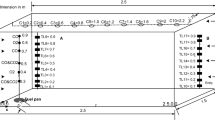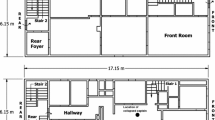Abstract
Fire simulation utilizing computational fluid dynamics (CFD) techniques was employed to reconstruct the aged-care facility fire incident that occurred in Quakers Hill, Sydney, in Nov 2011. Based on the sentence descriptions by the suspect and witnesses, the fire was intentionally lit on hospital beds sheets in an empty room and eventually spread to the entire building. The main objective of this simulation is to determine the fire origin and to gain insights into the fire development that resulted in three fatalities in the burn room. Preliminary numerical studies were initially performed in the model to investigate possible locations of the fire sources before the mock-up experiment was carried out in an actual size test room facility. The measured and predicted gas temperature from the thermocouple readings compared well, particularly with the peak temperature reaching approximately 900°C. Numerical simulation indicated that fire spread within the room was quickly established due to large amount of combustible materials being present and ample entrainment of air from the surroundings into the room through the window and doorway. This article illustrates the promising application of CFD for building fire modelling and simulation to provide evidences of criminal identification for fire investigation.
Similar content being viewed by others
References
Anderson DA, Tannehill JC, Pletcher RH (1984). Computational Fluid Mechanics and Heat Transfer. Philadelphia, USA: Hemisphere Publishing Corporation.
Atreya A (1983). Pyrolysis, ignition, and fire spread on horizontal surfaces of wood. Technical report GCR 83-449. Washington DC: National Bureau of Standards.
Babrauskas V (1977). Combustion of mattresses exposed to flaming ignition sources, Part I, Full-scale tests and hazard analysis. NBSIR 77-1290. Washington DC: National Bureau of Standards.
Babrauskas V (1980). Estimating room flashover potential. Fire Technology, 16: 94–103.
Bryner N, Madrzykowski D, Grosshandler W (2007). Reconstructing the Station Nightclub fire—Computer modelling of the fire growth and spread. In: Proceedings of 11th International Interflam Conference, London, UK, pp. 1181–1192.
Chou YL (1975). Statistical Analysis, Section 17.9. New York: Holt, Rinehart & Winston.
Delémont O, Martin JC (2007). Application of Computational Fluid Dynamics modelling in the process of forensic fire investigation: Problems and solutions. Forensic Science International, 167: 127–135.
Drysdale D (1985). An Introduction to Fire Dynamics, Chapter 9—The pre-flashover compartment fire. Bath, UK: Bookcraft (Bath) Ltd.
Grosshandler W (1993). RadCal: A narrow band model for radiation calculations in a combustion environment. NIST Technical Note TN 1402. Gaithersburg, MD, USA: National Institute of Standards and Technology.
Galea ER, Wang Z, Veeraswamy A, Jia F, Lawrence PJ, Ewer J (2008). Coupled fire/evacuation analysis of the Station Nightclub fire. Fire Safety Science, 9: 465–476.
Jukka H, Hostikka S, Jukka V (2004). FDS simulation of fire spread: Comparison of model results with experimental data. VTT Working Papers 4. Finland: VVT Information Service.
Kwek G, Gardiner S, Howden S (2011). ‘A firefighter’s worst nightmare’ as multiple deaths confirmed after fire breaks out in nursing home. Sydney Morning Herald, Retrieved 18 November 2011.
Lautenberger C, Fernandez-Pello C (2009). Generalized pyrolysis model for combustible solids. Fire Safety Journal, 44: 819–839.
Mardrzykowski D, Bryner N, Grosshandler WK, Stroup D (2003). Fire spread through a room with polyurethane foam covered walls. Gaithersurg, MD, USA: National Institute of Standards and Technology.
Mackay D, Barber T, Yeoh GH (2010). Experimental and computational studies of compartment fire behaviour training scenarios. Building and Environment, 45: 2620–2628.
McCurdy RJ, Atwell T, Cole MD (2001). The use of vapour phase ultra-violet spectroscopy for the analysis of arson accelerants in fire scene debris. Forensic Science International, 123: 191–201.
McGrattan K, Baum H, Rehm R (1998). Large eddy simulation of smoke movement. Fire Safety Journal, 30: 161–178.
McGrattan K, Hostikka S, Floyd J, Baum H, Rehm R (2007a). Fire Dynamics Simulator (Version 5) technical reference guide. NIST SP 1018-5. Gaithersurg, MD, USA: National Institute of Standards and Technology.
McGrattan K, Klein B, Hostikka S, Floyd J (2007b). Fire Dynamics Simulator (Version 5) user reference guide. NIST SP 1019-5. Gaithersurg, MD, USA: National Institute of Standards and Technology.
Prasad K, Kramer R, Marsh N, Nyden M, Ohlemiller T, Zammarano M (2009). Numerical simulation of fire spread on polyurethane foam slabs. Gaithersurg, MD, USA: National Institute of Standards and Technology.
Ritchie SJ, Steckler KD, Hamins A, Cleary TG, Yang JC, Kashiwagi T (1997). The effect of sample size on the heat release rate of charring materials. In: Proceedings of 5th International Symposium on Fire Safety Science, Melbourne, Australia, pp. 177–188.
Shen TS, Huang YH, Chien SW (2006). Using fire dynamics simulation (FDS) to reconstruct an arson fire scene. Building and Enviornment, 43: 1036–1045.
Skelly MJ, Roby RJ, Beyler CL (1991). An experimental investigation of glass breakage in compartment fires. Journal of Fire Protection Engineering, 3: 25–34.
Smagorinsky J (1963). General circulation experiment with the primitive equations: Part I. The basic experiment. Monthly Weather Review, 91: 99–164.
Thomas PH (1981). Testing products and materials for their contribution to flashover in rooms. Fire and Materials, 5: 103–111.
Welch S, Jowsey A, Deeny S, Morgan R, Torero JL (2007). BRE large compartment fire tests—Characterising post-flashover fires for model validation. Fire Safety Journal, 42: 548–567.
Author information
Authors and Affiliations
Corresponding author
Rights and permissions
About this article
Cite this article
Yuen, A.C.Y., Yeoh, G.H., Alexander, B. et al. Fire scene investigation of an arson fire incident using computational fluid dynamics based fire simulation. Build. Simul. 7, 477–487 (2014). https://doi.org/10.1007/s12273-014-0164-9
Received:
Revised:
Accepted:
Published:
Issue Date:
DOI: https://doi.org/10.1007/s12273-014-0164-9




